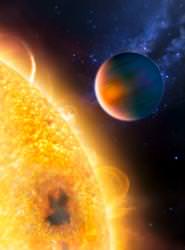The Hubble Space Telescope has turned up evidence for organic molecules on a planet orbiting another star. Organic molecules? Like the stuff we’re made of? Yes, but wait, this isn’t the discovery of life. In fact, it’s just the tell-tale signature of methane in the atmosphere of a distant, superheated planet.
The Jupiter-sized extrasolar planet is called HD 189733b, and it orbits a star about 63 light-years away in the constellation Vulpecula. Astronomers discovered that the planet is a member of the “hot Jupiter” class of planets, orbiting so close to its parent star that it only takes 2 days to complete an orbit.
This close orbit, much closer than the orbit of Mercury, raises the planet’s temperature to a sweltering 900 degrees Celsius – about the same temperature as the melting point of silver.
Here’s a computer animated video of the planet.
The observations were made using the transit method. This is where the planet passes directly in front of the parent star from our perspective. As it passes in front, it dims the light from the star slightly. And there’s a special bonus. As the planet is making this transit, astronomers can measure its atmosphere.
Using a technique called spectroscopy, the astronomers were able to split the light coming from the planet to reveal the fingerprints of various chemicals in its atmosphere. They confirmed the existence of water, turned up by NASA’s Spitzer Space Telescope back in 2007. But now they also found methane.
Under the right circumstances, methane can play a key role in prebiotic chemistry – the chemical reactions considered necessary to form life as we know it. Methane has been discovered in other planets in our own Solar System, so it doesn’t mean there’s life on HD 189733b (especially with its extremely hot temperatures). But finding methane around another planet, orbiting another star is an exciting advancement.
So even though life is out of the question on HD 189733b, the technique is the major news here. Astronomers will eventually be peering at smaller, more Earth-sized planets, and will be using this method to find other chemicals of life within stellar habitable zones.
If the life’s out there, astronomers are getting closer and closer to finding it.
The discovery was published in the March 20th issue of the journal Nature.
Original Source: Hubble News Release


this is quite exciting. Hopefully we can refine this technique with new technology to possibly find these molecules on earth like planets (at least in size).
Yes, methane works much better than oxidized monoxide or dioxide forms in constructing ‘carbon-based units’. Good detective work.
On earth, methane’s but a trace & perhaps the only lighter than moisture molecule in our troposphere. Some diehards might claim hydrogen(just passing through), helium, ammonia are lighter, but occur in trace amounts. Here, water is the main light molecule & green-house gas too.
This Vulpecula planet might be large enough to hold methane & water (both essential to life), but the boil order(900C) should dissipate them; & the speedy rotation might lose atmosphere to its ‘very close’ neighbor star. Therefore, methane must be produced or reduced(as carbon’s generated via supernovas). Here on earth, it’s already living things which produce the methane. Which came first?
:lolly: amazing !!!
The transit method is definitely going to be ‘where it’s at’ for extrasolar planetary research for the next 10-15 years I think (until a dedicated interferometer is constructed). So much information can be gleaned from the spectroscopy with such important ramifications for planetary formation theories (and more), that I wouldn’t be surprised to see the subject emerge as a preeminent field in astronomy in short order. Exciting times…
Another exciting step pregnant with promise for the future of discovery. ET, pay your phone bill.
Methane can be a signpost of life. But at 900C it’s unlikely that complex organic chemistry can occur – larger molecules would just fly apart.
Wow, let’s see if what turns up over the next few years
Since the ancestral time, world space research is progressing on wrong concept because we unknown about space mirror which is a great mystery and creator of lots of mysteries viz. milk ways, galaxies, nebulas, white duffs, black holes etcs. Hence without study of space mirror the space research has no future.
In sort it can not explain in short. Therefore it invites to visit http://www.spacemirrormystery.com to know the original truth
Mirror reflects frontier. Mirror functions like a wall. There is nothing ahead of mirror but reflection makes lively atmosphere into mirror. If two mirrors face each other in parallel position the concerned area between mirrors is converted to a biggest atmosphere because the concerned area reflected unlimitedly as front side and backside into each mirror frequently. Space mirror is based on above rule and we are unknown about space mirror.
From sun the objects of area 225 million kilometer to 300 million kilometer of solar system reflects unlimitedly, we find a very deep space and through giant telescopes we watch mystery after mystery.
Telescope enlarges view not closes near view. Following may clear the concept.
“A visitor of a desert often find mirage. If he moves, mirage also moves. He can never reach near the mirage. If he tries he can see enlarge view of mirage as smoky atmosphere through a telescopic instrumentâ€.
Giant telescope like Hubble and others may be the milestone of our technology but it can not help the real space research.